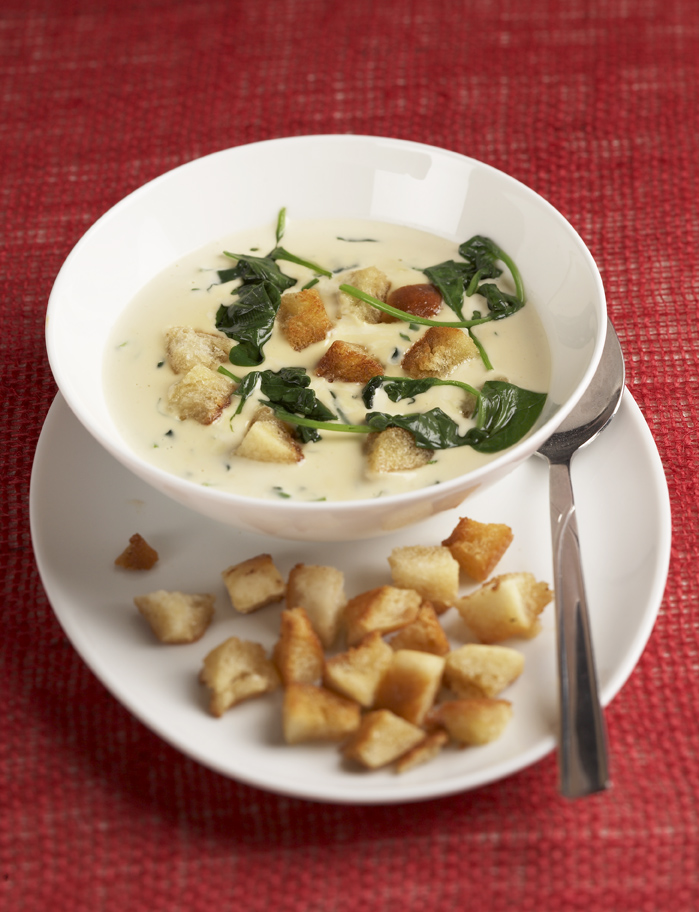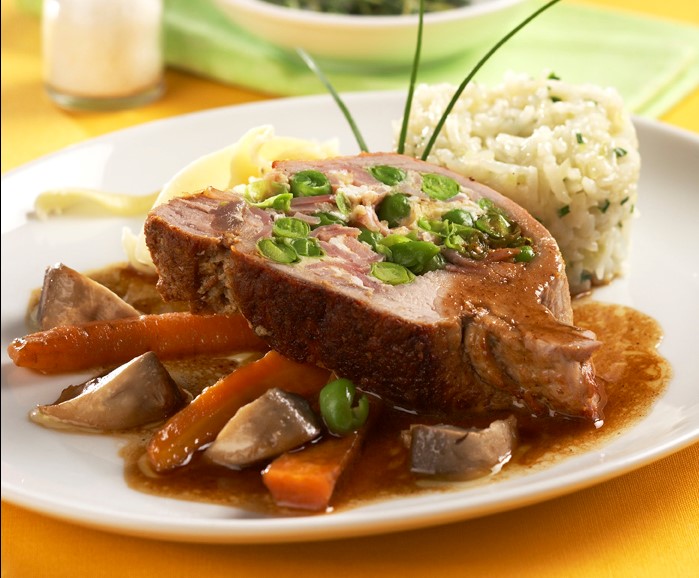After a long winter we all welcome in the spring and, as is customary in Czech cuisine, whatever grows in the garden during springtime immediately travels to the kitchen and ultimately, of course, to the plate. In early spring, when we also celebrate Easter, this mainly includes herbs. Young nettles, for example, are chopped into Easter stuffing that comprises old bread, smoked meat and eggs. This traditional stuffing is a must at any Czech Easter table. Each family has their own recipe, but steamed and chopped nettles simply must be included!
A mix of spring herbs is also added to soups, the taste of which is usually refined with sour cream. One of the unique regional Czech specialties is sorrel soup. Another healthy and extremely tasty spring soup is a fine cream of bear garlic, while parsley and chives must not be missing from any broth, whether used as a spice or as a parsley blend.

3/4 l meat broth
2 spoons butter
2 spoons all-purpose fine-grained flour / handful of sorrel leaves
salt
ground pepper
mace
100 ml cream
2 bread rolls, cut up into squares and toasted on a dry pan
Instructions:
Prepare a light roux from butter and flour, slowly add cold broth while stirring constantly. Stir well to combine, cook for about 20 minutes and then strain. Add salt, season with ground pepper and mace, add cream, and cook a while longer. Finally, add the clean and finely chopped sorrel leaves. Bring the soup to a boil and remove from the heat, do not continue cooking. Serve with the toasted bread roll croutons.
Another symbol of spring is the egg, and not just the traditional painted Easter egg. The festive boiled egg, which was always eaten together by all members of the family after returning from Sunday's Easter Mass, was a symbol of a new beginning and family cohesion. Here, too, herbs play an important role; eggs have always been sprinkled with as many types of herbs as there were family members at the table. However, this was only possible when Easter fell on a later date. If Easter came early, any able housewife would make do with the green sprout from last year's onion.
Spring cuisine also means early vegetables. Young spinach or chard sauteed with onion and flavoured with garlic can, together with a sunny-side-up egg, make just the right lunch for Maundy Thursday and an excellent side dish to Easter lamb roast. Young kohlrabi turnip can be used to prepare fine kohlrabi cabbage stew, which can be eaten alone, or used as a non-traditional side dish in place of the normally served stewed cabbage.
100 g onion
80 g butter or oil
50 g all-purpose fine-grained flour
0.5 dl cream
vinegar, salt, white pepper, mace
Peel the turnips, slice into thin strips or coarsely shred on a box grater. Finely chop the onion and cook in the butter, add the salt and vinegar. Dust with all-purpose flour, add the kohlrabi turnip and cook until soft. Towards the end, add cream to thicken as desired and finally season with mace.
Spring is the time when young meat should be on the table. Czech cuisine knows many modifications of lamb, goat and chicken, and veal meat is yet another delicacy. If you see, for example, a veal shank à la Prague on the menu, do not hesitate to order! You will be served veal with a stuffing of eggs, Prague ham and young peas.

2 eggs
100 g ham
1-2 spoons peas
white pepper
1 spoon oil
1 spoon butter
salt
Instructions:
Season the mixture of diced ham, peas and eggs with salt and pepper and let thicken on the cooktop. Using a pointed knife, create a pocket in the veal shank and stuff with the ham mixture. Secure with a skewer. Place the shank in a saucepan with oil and butter. Salt and braise. Add a little water, then roast slowly until golden, basting the meat with its own juices. Serve with rice or mashed potatoes.

Sorrel soup (Brčálka)
Ingredients:3/4 l meat broth
2 spoons butter
2 spoons all-purpose fine-grained flour / handful of sorrel leaves
salt
ground pepper
mace
100 ml cream
2 bread rolls, cut up into squares and toasted on a dry pan
Instructions:
Prepare a light roux from butter and flour, slowly add cold broth while stirring constantly. Stir well to combine, cook for about 20 minutes and then strain. Add salt, season with ground pepper and mace, add cream, and cook a while longer. Finally, add the clean and finely chopped sorrel leaves. Bring the soup to a boil and remove from the heat, do not continue cooking. Serve with the toasted bread roll croutons.
Another symbol of spring is the egg, and not just the traditional painted Easter egg. The festive boiled egg, which was always eaten together by all members of the family after returning from Sunday's Easter Mass, was a symbol of a new beginning and family cohesion. Here, too, herbs play an important role; eggs have always been sprinkled with as many types of herbs as there were family members at the table. However, this was only possible when Easter fell on a later date. If Easter came early, any able housewife would make do with the green sprout from last year's onion.
Spring cuisine also means early vegetables. Young spinach or chard sauteed with onion and flavoured with garlic can, together with a sunny-side-up egg, make just the right lunch for Maundy Thursday and an excellent side dish to Easter lamb roast. Young kohlrabi turnip can be used to prepare fine kohlrabi cabbage stew, which can be eaten alone, or used as a non-traditional side dish in place of the normally served stewed cabbage.
Kohlrabi cabbage stew
4 pieces young kohlrabi turnip100 g onion
80 g butter or oil
50 g all-purpose fine-grained flour
0.5 dl cream
vinegar, salt, white pepper, mace
Peel the turnips, slice into thin strips or coarsely shred on a box grater. Finely chop the onion and cook in the butter, add the salt and vinegar. Dust with all-purpose flour, add the kohlrabi turnip and cook until soft. Towards the end, add cream to thicken as desired and finally season with mace.
Spring is the time when young meat should be on the table. Czech cuisine knows many modifications of lamb, goat and chicken, and veal meat is yet another delicacy. If you see, for example, a veal shank à la Prague on the menu, do not hesitate to order! You will be served veal with a stuffing of eggs, Prague ham and young peas.

Prague stuffed veal shank
400 g veal shank2 eggs
100 g ham
1-2 spoons peas
white pepper
1 spoon oil
1 spoon butter
salt
Instructions:
Season the mixture of diced ham, peas and eggs with salt and pepper and let thicken on the cooktop. Using a pointed knife, create a pocket in the veal shank and stuff with the ham mixture. Secure with a skewer. Place the shank in a saucepan with oil and butter. Salt and braise. Add a little water, then roast slowly until golden, basting the meat with its own juices. Serve with rice or mashed potatoes.
